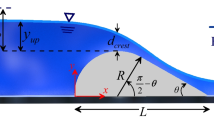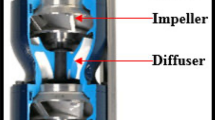Abstract
One of the most important instruments used in engineering is the statistical prediction of extreme values. Engineering design should envisage structural disaster resilience, in particular to withstand harsh environmental conditions during system operations. For instance, extreme value analysis can forecast the extreme values of the environment's wind and waves as well as engineering responses and moments. Although a variety of statistical techniques are employed to forecast extreme values, it is imperative to improve statistical techniques in order to enable improved forecasting. The innovative deconvolution strategy put forth in this study is one such way. Data on measured wind speeds were utilized to benchmark and evaluate the approach. Additionally, this method is employed to foretell the extreme values of a unique subsea shuttle tanker (SST), a cutting-edge undersea freight tanker that transports CO2 to marginal fields. The novel deconvolution method’s results are validated against the modified Weibull extrapolation method. Time-domain-stimulated 2D planar Simulink model was used to generate representative underlying dynamic system dataset. The proposed methodology provides an accurate response to extreme value prediction utilizing all available data efficiently, which enables modelling and design optimizations of the SST. The proposed deconvolution method’s overall performance indicated that the extreme response prediction results of the dynamic vessel motion numerical simulations are robust and accurate. Significance and importance of this study lie within addressing state-of-art carbon capture and storage subsea system, in particular its safety and reliability design aspects.









Similar content being viewed by others
Data availability
Available on request.
Abbreviations
- SST:
-
Subsea shuttle tanker
- CCS:
-
Carbon capture and storage
References
Balakrishna R, Gaidai O, Wang F, Xing Y, Wang S (2022) A novel design approach for estimation of extreme load responses of a 10-MW floating semi-submersible type wind turbine. Ocean Eng 261:1282. https://doi.org/10.1016/j.oceaneng.2022.112007
Capture and Storage Association (CCSA) (2020) Carbon Capture and Storage Association (CCSA) What Is CCS?. http://www.ccsassociation.org/what-is-ccs/. Assessed Sep 2020
Chaos D, Moreno-Salinas D, Aranda J (2022) Fault-tolerant control for AUVs using a single thruster. IEEE Access 10:22123–22139
Ellingsen, K.E.; Ravndal O.; Reinas, R.; Hansen, J.H.; Marra, F.; Myhre, E.; Dupuy, P.M.; Sveberg, K. 2020. RD677082 Subsea shuttle system.
Equinor Energy AS. 2019. RD662093 Subsea shuttle system.
Equinor Northern Lights. 2019. https://www.equinor.com/energy/northern-lights
Gaidai O, Xing Y (2022) Novel reliability method validation for offshore structural dynamic response. Ocean Eng 266(5):113016. https://doi.org/10.1016/j.oceaneng.2022.113016
Gaidai O, Xing Y (2022a) A novel multi regional reliability method for COVID-19 death forecast. Eng Sci https://doi.org/10.30919/es8d799
Gaidai O, Xing Y (2022b) A novel bio-system reliability approach for multi-state COVID-19 epidemic forecast. Eng Sci https://doi.org/10.30919/es8d797
Gaidai O, Xing Y (2023a) Prediction of death rates for cardiovascular diseases and cancers. Cancer Innov https://doi.org/10.1002/cai2.47
Gaidai O, Xing Y (2023b) COVID-19 Epidemic Forecast in Brazil. Bioinform Biol Insights. https://doi.org/10.1177/11779322231161939
Gaidai O, Naess A, Xu X, Cheng Y (2019a) Improving extreme wind speed prediction based on a short data sample, using a highly correlated long data. J Wind Eng Ind Aerodyn 188:102–109
Gaidai O, Naess A, Karpa O, Cheng Y, Ye R (2019b) Improving extreme wind speed prediction for North Sea offshore oil and gasfields. Appl Ocean Res https://doi.org/10.1016/j.apor.2019.04.024
Gaidai O, Xu X, Wang J, Cheng Y, Ye R, Karpa O (2020) SEM-REV offshore energy site wind-wave bivariate statistics. Renewable Energy 156:689–695
Gaidai O, Yan P, Xing Y, Xu J, Wu Y (2022a) A novel statistical method for long-term coronavirus modelling. F1000 Res 11:1282
Gaidai O, Xing Y, Balakrishna R (2022b) Improving extreme response prediction of a subsea shuttle tanker hovering in ocean current using an alternative highly correlated response signal. Res Eng https://doi.org/10.1016/j.rineng.2022.100593
Gaidai O, Fu S, Xing Y (2022c) Novel reliability method for multidimensional nonlinear dynamic systems. Marine Struct https://doi.org/10.1016/j.marstruc.2022.103278
Gaidai O, Yan P, Xing Y (2022d) A novel method for prediction of extreme wind speeds across parts of Southern Norway. Front Environ Sci 10:997216
Gaidai O, Yan P, Xing Y (2022e) Prediction of extreme cargo ship panel stresses by using deconvolution. Front Mech Eng 8:992177
Gaidai O, Wang F, Wu Y, Xing Y, Medina A, Wang J (2022f) Offshore renewable energy site correlated wind-wave statistics. Probab Eng Mech 68:103207
Gaidai O, Xu J, Yan P, Xing Y, Zhang F, Wu Y (2022g) Novel methods for wind speeds prediction across multiple locations. Sci Rep 12:19614. https://doi.org/10.1038/s41598-022-24061-4
Gaidai O, Wu Y, Yegorov I, Alevras P, Wang J, Yurchenko D (2022h) Improving performance of a nonlinear absorber applied to a variable length pendulum using surrogate optimization. J Vib Control https://doi.org/10.1177/10775463221142663
Gaidai O, Wang K, Wang F, Xing Y, Yan P (2022i) Cargo ship aft panel stresses prediction by deconvolution. Marine Struct. https://doi.org/10.1016/j.marstruc.2022.103359
Gaidai O, Xu J, Xing Y, Hu Q, Storhaug G, Xu X, Sun J (2022j) Cargo vessel coupled deck panel stresses reliability study. Ocean Eng https://doi.org/10.1016/j.oceaneng.2022.113318
Gaidai O, Xu J, Hu Q, Xing Y, Zhang F (2022k) Offshore tethered platform springing response statistics. Sci Rep 12:21182
Gaidai O, Xu J, Yan P et al (2023a) Novel methods for reliability study of multi-dimensional non-linear dynamic systems. Sci Rep 13:3817. https://doi.org/10.1038/s41598-023-30704-x
Gaidai O, Yan P, Xing Y (2023b) Future world cancer death rate prediction. Sci Rep https://doi.org/10.1038/s41598-023-27547-x
Gaidai O, Xing Y, Xu X (2023c) Novel methods for coupled prediction of extreme wind speeds and wave heights. Sci Rep https://doi.org/10.1038/s41598-023-28136-8
Gaidai O, Cao Y, Xing Y, Wang J (2023d) 2023, Piezoelectric Energy Harvester Response Statistics. Micromachines 14(2):271. https://doi.org/10.3390/mi14020271
Gaidai O, Cao Y, Loginov S (2023e) Global cardiovascular diseases death rate prediction. Curr Probl Cardiol https://doi.org/10.1016/j.cpcardiol.2023.101622
Gaidai O, Cao Y, Xing Y, Balakrishna R (2023f) Extreme springing response statistics of a tethered platform by deconvolution. Int J Naval Arch Ocean Eng https://doi.org/10.1016/j.ijnaoe.2023.100515
Gaidai O, Xing Y, Balakrishna R, Xu J (2023g) Improving extreme offshore wind speed prediction by using deconvolution. Heliyon. https://doi.org/10.1016/j.heliyon.2023.e13533
Gaidai O, Wang F, Yakimov V (2023h) COVID-19 multi-state epidemic forecast in India. Proc Indian Natl Sci Acad https://doi.org/10.1007/s43538-022-00147-5
Gaidai O, Xu X, Xing Y (2023i) Novel deconvolution method for extreme FPSO vessel hawser tensions during offloading operations. Res Eng https://doi.org/10.1016/j.rineng.2022.100828
Gaidai O, Cao Y, Xu X, Xing Y (2023j) Offloading operation bivariate extreme response statistics for FPSO vessel. Sci Rep https://doi.org/10.1038/s41598-023-31533-8
Gaidai O, Wang F, Xing Y, Balakrishna R (2023k) Novel reliability method validation for floating wind turbines. Adv Energy and Sustain Res https://doi.org/10.1002/aesr.202200177
Gaidai O, Hu Q, Xu J, Wang F, Cao Y (2023l) Carbon storage tanker lifetime assessment. Global Chall https://doi.org/10.1002/gch2.202300011
He, K.; Du, Y.; Gao, S.; Zhong, D.; Shen, Y.; He, B. 2021. Fault diagnosis of full-drive AUV based on graph theory and recurrent neural network. In OCEANS 2021: San Diego–Porto (pp. 1–6). IEEE.
Kadiyam J, Parashar A, Mohan S, Deshmukh D (2020) Actuator fault-tolerant control study of an underwater robot with four rotatable thrusters. Ocean Eng 197:106929
Li X, Wei H, Xiao L, Cheng Z, Liu M (2021) Study on the effects of mooring system stiffness on air gap response. Ocean Eng 239:109798
Liu Z, Gaidai O, Xing Y, Sun J (2023) Deconvolution approach for floating wind turbines. Energy Sci Eng https://doi.org/10.1002/ese3.1485
Luenberger DG (1971) An introduction to observers. IEEE Trans Autom Control 16(6):596–602
Ma Y, Xing Y, Ong MC, Hemmingsen T (2021a) Baseline design of a subsea shuttle tanker system for liquid carbon dioxide transportation. J Ocean Eng 240:109891
Ma, Y.; Sui, D.; Xing, Y.; Ong, M.C.; Hemmingsen, T.H. 2021b. Depth control modelling and analysis of a subsea shuttle tanker. International Conference on Offshore Mechanics and Arctic Engineering, OMAE2021b–61924, Virtual, Accessed 21–30 June 2021b.
Ma, Y.; Silva, M.S.D; Xing, Y.H.; Sui, D. 2022. Modelling of a subsea shuttle tanker hovering in ocean current, International Conference on Ocean, Offshore and Artic Engineering, Hamburg, Germany, Accessed 5–10 June 2022.
Muliawan MJ, Gao Z, Moan T (2013) Application of the contour line method for estimating extreme responses in the mooring lines of a two-body floating wave energy converter. J Offshore Mech Arctic Eng. https://doi.org/10.1115/1.4024267)
Norwegian Petroleum Directorate (NPD). 2021. Carbon Capture and Storage. http://www.norskpetroleum.no/en/environment-and-technology/carbon-capture-and-storage/ Accessed 1 Aug 2021
Xing Y, Gaidai O (2023) Multi-regional COVID-19 epidemic forecast in Sweden. Digital Health. https://doi.org/10.1177/20552076231162984
Xing Y, Ong MC, Hemmingsen T, Ellingsen KE, Reinas L (2021a) Design considerations of a subsea shuttle tanker system for liquid carbon dioxide transportation. J Offshore Mech Arctic Eng 143(4):045001
Xing Y, Santoso TAD, Ma Y (2021b) Technical—economic feasibility analysis of subsea shuttle tanker. J Marine Sci Eng 10(1):20
Xu X, Gaidai O, Naess A, Sahoo P (2019) Improving the prediction of extreme FPSO hawser tension, using another highly correlated hawser tension with a longer time record. Appl Ocean Res 88:89–98
Xu X, Gaidai O, Yakimov V, Xing Y, Wang F (2023) FPSO offloading operational safety study by a multidimensional reliability method. Ocean Eng 281:114652
Zhang J, Gaidai O, Ji H, Xing Y (2023) Operational reliability study of ice loads acting on oil tanker bow. Heliyon. https://doi.org/10.1016/j.heliyon.2023.e15189
Funding
The authors have not disclosed any funding.
Author information
Authors and Affiliations
Contributions
All authors have contributed equally.
Corresponding author
Ethics declarations
Conflict of interest
The authors have not disclosed any competing interests..
Ethical approval
Not applicable.
Consent to participate
Not applicable.
Consent for publication
All authors agreed.
Rights and permissions
Springer Nature or its licensor (e.g. a society or other partner) holds exclusive rights to this article under a publishing agreement with the author(s) or other rightsholder(s); author self-archiving of the accepted manuscript version of this article is solely governed by the terms of such publishing agreement and applicable law.
About this article
Cite this article
Yakimov, V., Gaidai, O., Xu, J. et al. Liquid carbon storage tanker disaster resilience. Environ Syst Decis 43, 746–757 (2023). https://doi.org/10.1007/s10669-023-09922-1
Accepted:
Published:
Issue Date:
DOI: https://doi.org/10.1007/s10669-023-09922-1




